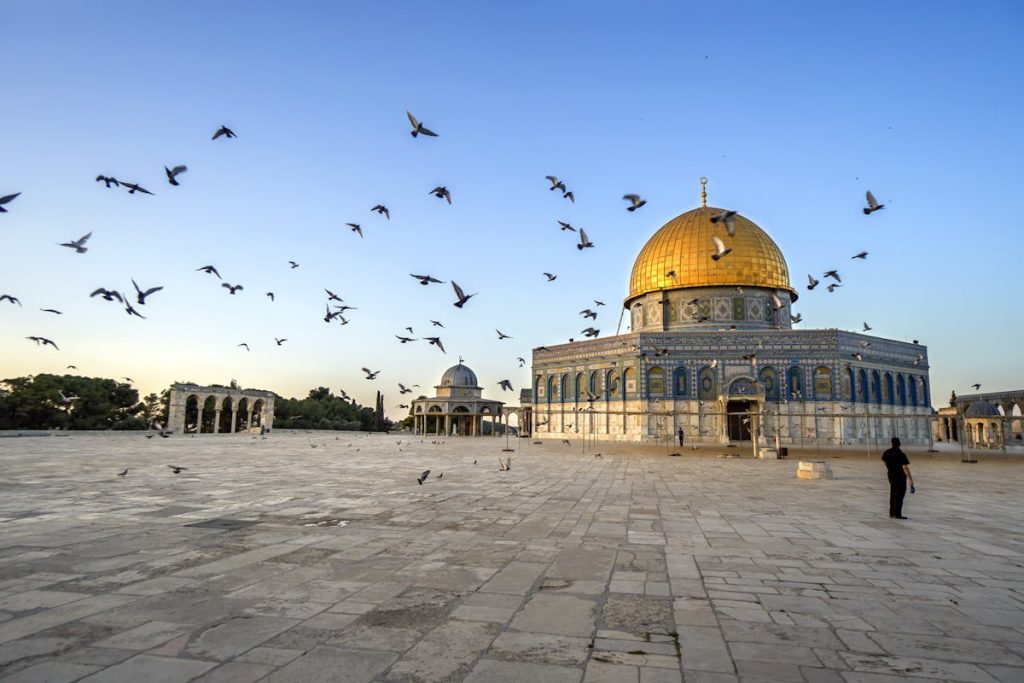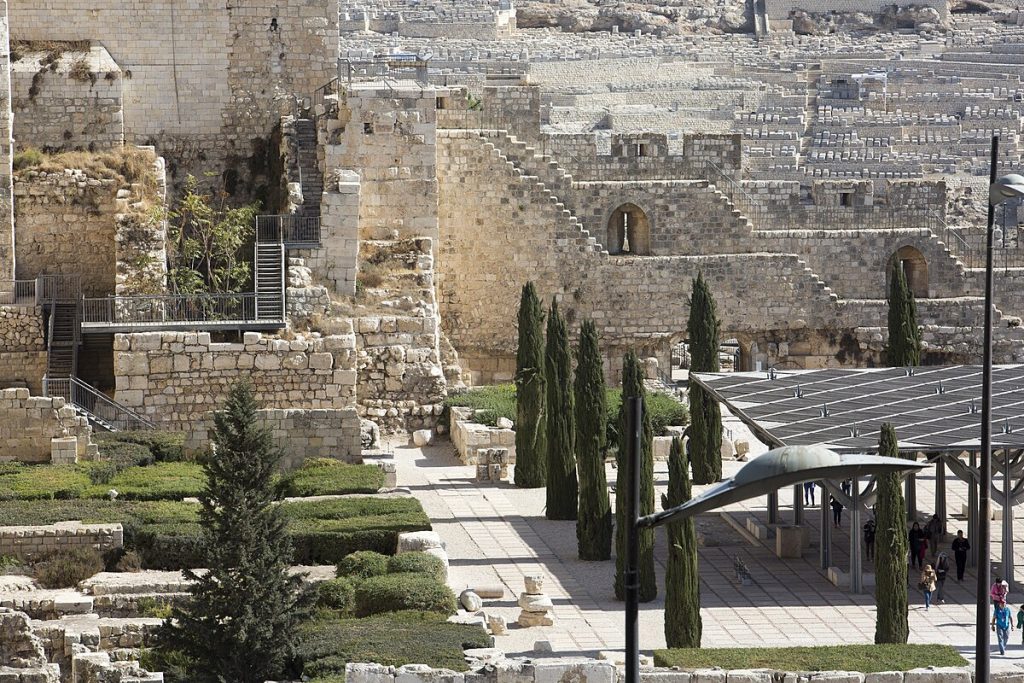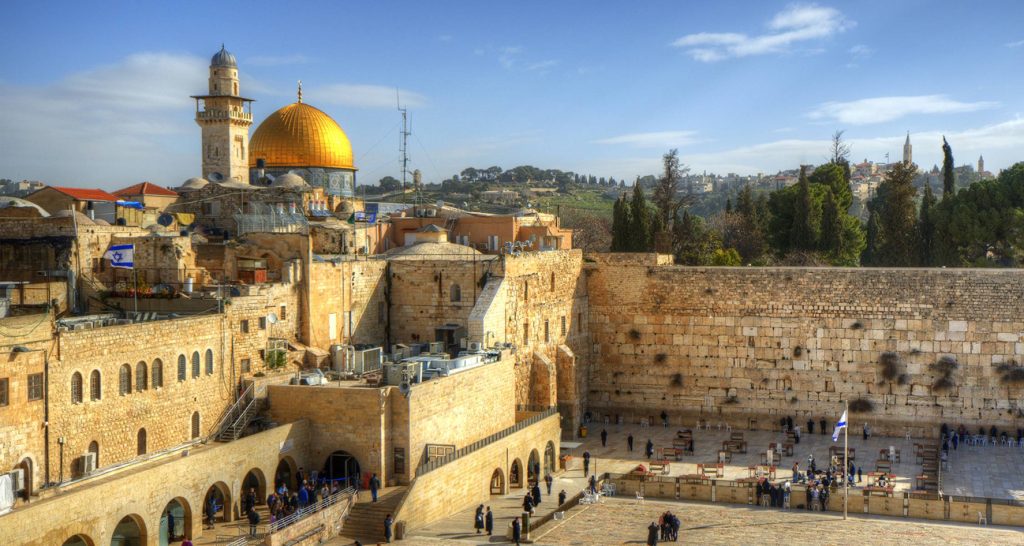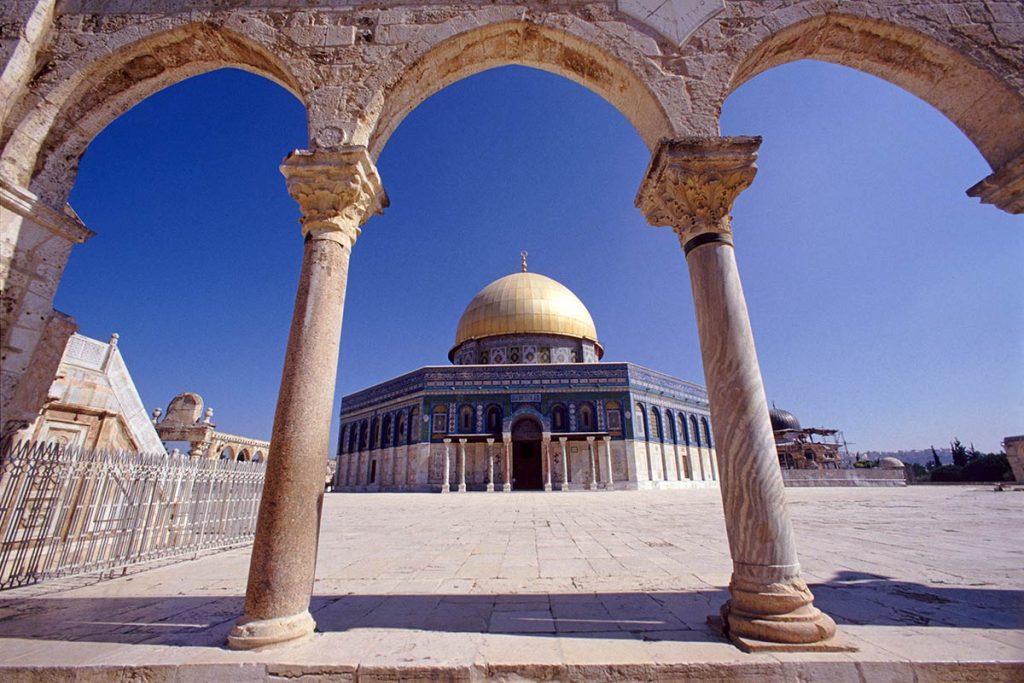The view of the city is the history of the world; it is more, it is the history of earth and of heaven

Jerusalem is one of the oldest and most historically significant cities in the world, with a history that stretches back thousands of years. Located in the Middle East, it serves as a central cultural, religious, and political hub for many. The city is sacred to three major religions: Judaism, Christianity, and Islam. For Jews, it is home to the Western Wall, the last remnant of the Second Temple, making it one of the holiest sites in Judaism. Christians revere Jerusalem as the place where Jesus Christ was crucified and resurrected, with key sites such as the Church of the Holy Sepulchre marking important moments in Jesus’ life. For Muslims, the Al-Aqsa Mosque, located in the Old City of Jerusalem, is considered one of the holiest sites in Islam, being the destination of the Prophet Muhammad’s Night Journey and ascension to heaven. Jerusalem’s religious and political significance has made it a focal point of both peaceful pilgrimage and violent conflict throughout history. The city has seen numerous empires, from the ancient Egyptians to the Romans, Byzantines, Crusaders, Ottomans, and, more recently, the Israeli and Palestinian conflicts. Today, Jerusalem is a modern city with a complex mix of ancient history, diverse cultures, and contemporary challenges. Its status remains a subject of international debate, as both Israel and Palestine claim it as their capital, and its Old City, a UNESCO World Heritage Site, remains a place of deep spiritual reverence and political tension. The ongoing disputes surrounding its borders and governance make Jerusalem a focal point of geopolitics, embodying the complex intersection of faith, history, and national identity.
The City

The City of Jerusalem is a place of profound historical, spiritual, and political importance, located in the heart of the Middle East. It is one of the oldest cities in the world, with evidence of continuous habitation dating back over 5,000 years. Jerusalem has been the center of major religious and cultural developments and is considered a spiritual epicenter by Judaism, Christianity, and Islam.
The city’s landscape is defined by the Old City, a UNESCO World Heritage site enclosed by ancient walls, and the modern city surrounding it, which serves as the capital of Israel. The Old City is divided into four quarters: the Jewish Quarter, the Christian Quarter, the Muslim Quarter, and the Armenian Quarter, each filled with sacred sites and rich histories. Among its most iconic landmarks are the Western Wall, a remnant of the ancient Second Temple and one of the holiest places for Jews; the Church of the Holy Sepulchre, believed to be the site of Jesus’ crucifixion and burial, significant to Christians; and the Al-Aqsa Mosque, an important place of worship for Muslims.
Jerusalem has been at the crossroads of conflict, diplomacy, and faith. Throughout history, it has been controlled by various empires, including the Romans, Byzantines, Crusaders, and Ottomans. It was captured and recaptured many times, and its significance has led to many struggles for control, particularly in modern times. The city’s status is deeply contested in the Israeli-Palestinian conflict, with both Israelis and Palestinians claiming it as their capital. The political situation in Jerusalem is extremely complex, with its religious and cultural heritage entwined in its geopolitical tensions.
Today, Jerusalem remains a city of contrast—where ancient traditions coexist with modern life. Its streets are a mix of the old and new, with bustling markets, historical sites, and modern buildings, all surrounded by an ongoing narrative of religious devotion, political struggle, and cultural identity. Despite the challenges and disputes that surround the city, Jerusalem continues to draw people from all over the world, each with a personal connection to its sacred history and significance.
Different names

Jerusalem has been known by various names throughout history, each reflecting its cultural, religious, and historical significance. Here are some of the different names that Jerusalem has been called:
-
Jerusalem – The most widely recognized name, derived from ancient Hebrew, “Yerushalayim,” which is believed to mean “City of Peace” or “Foundation of Peace.”
-
Al-Quds – The Arabic name for Jerusalem, meaning “The Holy.” It is commonly used by Muslims and is associated with the city’s significance in Islam.
-
Zion – A term that originally referred to a hill in Jerusalem, but over time it has come to symbolize the city itself and the biblical concept of the “Promised Land” in Jewish tradition. It is often used poetically to refer to Jerusalem.
-
The City of David – This name refers specifically to the ancient core of Jerusalem, which was established as the capital of the Kingdom of Israel by King David around 1000 BCE. The archaeological site of the City of David is a significant historical landmark.
-
The Holy City – A title used to emphasize Jerusalem’s importance to Judaism, Christianity, and Islam as a center of sacred sites and pilgrimage.
-
Yerushalayim – The Hebrew form of Jerusalem, used in the Jewish tradition, including in religious texts like the Bible.
-
Jebus – The name of Jerusalem before it was conquered by King David. It was inhabited by the Jebusites, a Canaanite people, and this name appears in some ancient texts.
-
The City of Peace – The meaning often associated with the name “Jerusalem” itself, reflecting its hopeful association with peace, though ironically, the city has seen much conflict throughout history.
-
The City of Gold – This name is sometimes used poetically, particularly in Hebrew songs and poetry, to express Jerusalem’s radiant beauty and spiritual importance.
-
Aelia Capitolina – The Roman name for Jerusalem, given after Emperor Hadrian rebuilt the city in the 2nd century CE following the Jewish revolt. “Aelia” was his family name, and “Capitolina” referred to the Roman god Jupiter, whose temple was constructed in the city.
Each of these names highlights a different aspect of Jerusalem’s rich and diverse history, reflecting its significance in the ancient world, as well as its ongoing importance in religious and political contexts.
THE OLD CITY

The Old City of Jerusalem is a historic and religiously significant area located within the modern city of Jerusalem. It is one of the most important and sacred sites in the world, containing several key landmarks for Judaism, Christianity, and Islam. Enclosed by ancient walls, the Old City is a UNESCO World Heritage site, and its narrow, winding streets are filled with centuries of history, religious devotion, and cultural heritage.
Divisions of the Old City
The Old City is divided into four distinct quarters:
-
The Jewish Quarter: This area is home to many important Jewish sites, most notably the Western Wall (also known as the Wailing Wall), a remnant of the ancient Second Temple and one of the holiest sites in Judaism. The Jewish Quarter is also home to synagogues, ancient courtyards, and archaeological sites that reflect the long history of Jewish presence in Jerusalem.
-
The Christian Quarter: This quarter is significant for Christians as it contains the Church of the Holy Sepulchre, where many Christians believe Jesus was crucified, buried, and resurrected. The Church is one of the most visited Christian pilgrimage sites in the world. The Christian Quarter is also home to various other churches and religious institutions.
-
The Muslim Quarter: Home to several important Islamic sites, including the Al-Aqsa Mosque, which is one of the holiest places in Islam. The Dome of the Rock, another important Islamic site, is located on the Temple Mount in the Old City. The Muslim Quarter is a vibrant area, with bustling markets, mosques, and residences.
-
The Armenian Quarter: This area is inhabited by the Armenian community of Jerusalem, one of the oldest Christian communities in the city. The Armenian Quarter includes historical sites such as the Armenian Patriarchate and several Armenian churches, as well as museums and courtyards that offer a glimpse into the rich cultural and religious history of the Armenians in Jerusalem.
Key Landmarks and Sites:
- The Western Wall (Wailing Wall): This ancient wall is all that remains of the Second Temple, destroyed by the Romans in 70 CE. It is a place of prayer and pilgrimage for Jews, who come to the wall to offer prayers, reflect, and place written prayers into the crevices of the wall.
- The Church of the Holy Sepulchre: Considered by many to be the site of Jesus’ crucifixion, burial, and resurrection, the Church is a major Christian pilgrimage destination and one of the holiest Christian sites.
- The Dome of the Rock: Located on the Temple Mount, this iconic structure is one of the most recognizable landmarks in Jerusalem. It is believed by Muslims to be the site of Prophet Muhammad’s Night Journey and ascension to heaven.
- Al-Aqsa Mosque: A significant place of worship for Muslims, Al-Aqsa Mosque is located near the Dome of the Rock on the Temple Mount and is the third holiest mosque in Islam.
- The Via Dolorosa: This is the route that many Christians believe Jesus walked on the way to his crucifixion. The street is marked with Stations of the Cross and leads to the Church of the Holy Sepulchre.
- The Citadel of David: Also known as the Tower of David, this ancient fortress offers a glimpse into the city’s military history. It also serves as a museum showcasing the history of Jerusalem.
The Walls of the Old City
The Old City is surrounded by imposing stone walls, built in the 16th century by the Ottoman Sultan Suleiman the Magnificent. The walls are punctuated by several gates, each with its own significance:
- Jaffa Gate: The most famous and busiest gate, located near the Christian and Armenian Quarters.
- Damascus Gate: The most majestic entrance to the Old City, leading into the Muslim Quarter.
- Herod’s Gate: Leading into the Muslim Quarter, it is named after King Herod, the ruler of Judea during the time of Jesus.
- Zion Gate: Leading to the Jewish Quarter, it is located near Mount Zion and the Room of the Last Supper.
- Golden Gate: A sealed gate that has religious significance, especially in Jewish and Christian traditions.
Religious Significance
The Old City of Jerusalem is not just a physical space but a deeply spiritual one for millions of people around the world. For Jews, it represents the spiritual and historical heart of their faith, with the Western Wall serving as a symbol of hope and endurance. For Christians, the city is a place of reflection and pilgrimage, especially through sites like the Church of the Holy Sepulchre and the Via Dolorosa. For Muslims, the Temple Mount, with the Dome of the Rock and Al-Aqsa Mosque, is considered one of the holiest places, and the city is integral to Islamic history.
A Living City
While the Old City is a place of ancient significance, it is also a vibrant and living area. Its streets are lined with shops, cafes, and market stalls, where visitors and locals alike engage in commerce, culture, and daily life. The mixture of religious devotion, historic landmarks, and the energy of modern life makes the Old City of Jerusalem a unique and compelling destination for people of all backgrounds.
The Old City remains a focal point of political and religious tensions, and its status is a key issue in the Israeli-Palestinian conflict. Despite the complex and often contentious circumstances, the Old City continues to be a symbol of the intertwining of faith, history, and identity in Jerusalem.
6 Interesting Facts about AL QUDS
Al-Quds, the Arabic name for Jerusalem, holds a special place in the hearts of Muslims around the world. Here are six interesting facts about this revered city:
1. A Sacred City for Three Religions
Al-Quds is one of the few cities in the world that holds deep significance for three major religions: Judaism, Christianity, and Islam. For Muslims, it is the third holiest city after Mecca and Medina. It is the site of the Al-Aqsa Mosque and the Dome of the Rock, both of which hold deep spiritual significance in Islamic tradition.
2. The Prophet Muhammad’s Night Journey
According to Islamic tradition, Al-Quds is where the Prophet Muhammad is believed to have embarked on his Isra and Mi’raj (Night Journey and Ascension). Muslims believe that, from the Al-Aqsa Mosque, Prophet Muhammad was taken by the Angel Jibril (Gabriel) on a miraculous journey to the heavens. This event is commemorated annually on Lailat al-Miraj, an important night in the Islamic calendar.
3. The Dome of the Rock and its Unique Architecture
The Dome of the Rock, located on the Temple Mount in Al-Quds, is one of the most iconic and oldest examples of Islamic architecture. Completed in 691 CE, it features a stunning golden dome that has become a symbol of Jerusalem itself. The rock inside the dome is believed to be the spot where the Prophet Muhammad ascended to heaven, making it a highly revered site.
4. The Old City’s Status as a UNESCO World Heritage Site
Al-Quds’ Old City, which houses the holy sites for all three Abrahamic faiths, was designated a UNESCO World Heritage site in 1981. The Old City is surrounded by walls dating back to the 16th century, and within its boundaries lie the Western Wall, the Church of the Holy Sepulchre, and the Al-Aqsa Mosque, among other historical landmarks.
5. A City of Contrasting Cultures
Al-Quds is home to people from various ethnic and religious backgrounds. The city is divided into several quarters—Jewish, Christian, Muslim, and Armenian. Each group has its own neighborhoods, religious sites, and cultural practices, but they coexist within the same geographical space, giving the city a unique and rich cultural tapestry.
6. Historical Significance Across Empires
Throughout history, Al-Quds has been under the control of many different empires and dynasties, each leaving its mark on the city’s architecture and culture. The city has been ruled by the Romans, Byzantines, Crusaders, Ottomans, and now modern Israel. Each period of rule contributed to the city’s unique blend of ancient and modern elements, as seen in its blend of architectural styles, from Roman ruins to Ottoman mosques and modern structures.
These fascinating facts highlight the deep historical and spiritual connection that Al-Quds holds for many, as well as its role in the ongoing cultural and political landscape of the region.
THE CONTEMPORARY SIDE OF THE CITY
The contemporary side of Jerusalem blends modern life with its rich historical and religious significance. As the capital of Israel, it serves as a political hub, housing key government institutions like the Knesset and the Prime Minister’s residence. The city has undergone significant development in recent decades, with new neighborhoods, shopping centers, and public infrastructure like the Jerusalem Light Rail. It’s also a growing cultural center, with a vibrant arts scene, museums, and festivals, alongside a burgeoning culinary landscape, highlighted by bustling markets like Mahane Yehuda. Despite its modernity, Jerusalem faces ongoing political and social tensions, often reflected in its complex relationship between different ethnic and religious communities. The city’s blend of old and new makes it a unique place where tradition coexists with contemporary progress.

BEST PLACES TO VISIT WHILE THERE:

-
Western Wall – The holiest site in Judaism, where people come to pray and reflect.
-
Church of the Holy Sepulchre – A major Christian pilgrimage site, believed to be the location of Jesus’ crucifixion, burial, and resurrection.
-
Al-Aqsa Mosque – One of Islam’s holiest sites, located on the Temple Mount, offering spiritual significance for Muslims.
-
Dome of the Rock – An iconic symbol of Jerusalem, believed to be the site of Prophet Muhammad’s Night Journey and ascension.
-
The Israel Museum – Home to a vast collection of artifacts, including the Dead Sea Scrolls and important archaeological finds.
-
Mahane Yehuda Market – A bustling market offering local produce, spices, street food, and a lively atmosphere.
-
Mount of Olives – Offering panoramic views of the Old City, this site is sacred to both Christians and Jews.
-
Yad Vashem Holocaust Memorial – A powerful museum and memorial dedicated to the victims of the Holocaust.
-
The Tower of David Museum – A historical museum showcasing Jerusalem’s fascinating history through interactive exhibits.
-
Garden of Gethsemane – A peaceful garden with ancient olive trees, significant to Christians for its connection to Jesus’ final prayers.
-
Zion Gate – A historic entrance to the Old City, offering a glimpse into Jerusalem’s layered past.
The Wailing Wall – The Kotel
The Wailing Wall, also known as the Kotel, is one of the most sacred sites in Judaism, located in the Old City of Jerusalem. It is a remnant of the Second Temple, which was destroyed by the Romans in 70 CE, and is considered the last standing structure of the ancient Temple Mount. For Jews, the Kotel is a place of prayer, reflection, and connection to their ancestral roots. It is a tradition for visitors to write prayers on small pieces of paper and place them in the cracks of the wall. The site draws millions of pilgrims and tourists annually, and its significance extends beyond religious practice, symbolizing Jewish endurance and hope throughout centuries of hardship.

Dome of the Rock

The Dome of the Rock is one of the most iconic and revered landmarks in Jerusalem, located on the Temple Mount. Completed in 691 CE, it is an exquisite example of early Islamic architecture, with its stunning golden dome that dominates the skyline of the Old City. The Dome is built over a rock that holds significant religious importance in both Judaism and Islam. For Muslims, it is believed to be the site where the Prophet Muhammad ascended to heaven during the Isra and Mi’raj (Night Journey). For Jews, the rock is traditionally considered the site where Abraham prepared to sacrifice his son Isaac. The Dome of the Rock is not only an architectural masterpiece but also a symbol of Jerusalem’s deep spiritual significance for multiple faiths, and it remains one of the most visited and photographed sites in the city.
